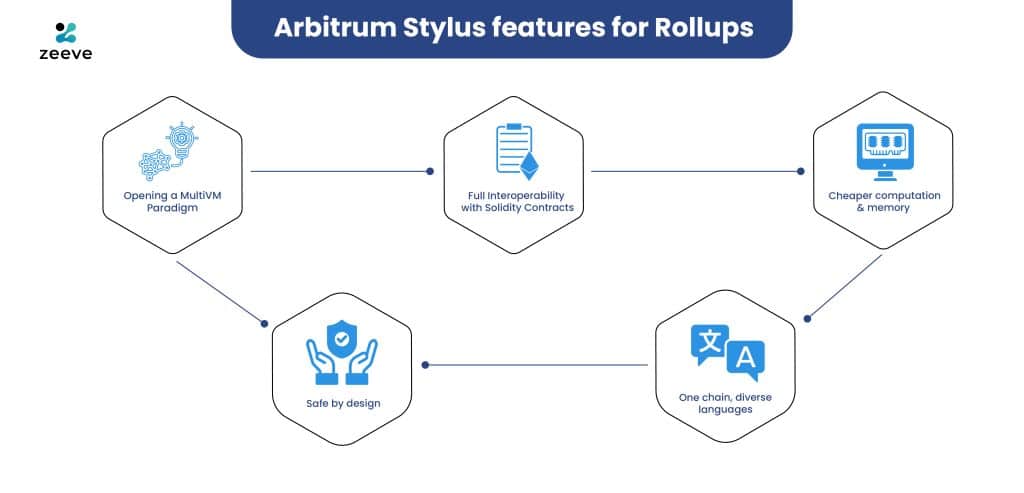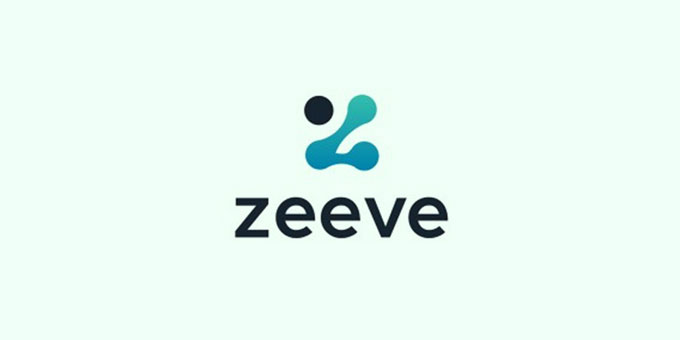Arbitrum continues to unleash innovation and foster collaboration across L2/L3 chains. The recent launch of Arbitrum Stylus mainnet is a testimony to this. Arbitrum, with its market-leading Layer2 technology stack, has already been empowering enterprises and builders to launch their rollup chains. However, the gap between the EVM tech stack and the web2 stack was hindering the adoption. Now, with the Stylus upgrade, Arbitrum is able to strategically bridge this gap, allowing a much more composable rollup creation with a focus on its motto of ‘your chain, Your rules’.
Let’s dive deeper into Arbitrum Stylus in this article. We’ll learn about each of its aspects, from basic definitions to benefits, cutting-edge features for rollups, possible use cases, and projects building on it.
What is Arbitrum Stylus?
Arbitrum Stylus is a first-of-kind technology and an important upgrade to the Nitro stack which powers Arbitrum One, Arbitrum Nova, and Orbit chains. Stylus is designed to be additive to EVM, not to replace it. Therefore, Stylus EVM brings a concept of the coequal virtual machine in which WebAssembly (WASM) serves as the second virtual machine. Any L2/L3 chains building with Arbitrum can use mainstream languages like Rust, C, and C++ to write smart contracts, eliminating their dependency on Solidity. WASM programs have proved to be more efficient than Solidity, and that’s the reason for Stylus’ faster execution, low computation, and high runtime attributes. However, note that Solidity and Stylus contracts are interoperable with each other. Together with all these, Arbitrum Stylus is enabling advanced use cases for diverse web3 projects.
Source: Arbitrum Docs
What problems Arbitrum Stylus mainly solve?
Arbitrum Stylus solves the two key problems in L2/L3 blockchains and rollups; lack of accessibility and execution inefficiency of smart contracts. Let’s understand this better:
- Enhancing blockchain accessibility for builders:
According to the Developer Report, there are 26000+ monthly active developers in the blockchain domain, and this number is notably greater than in the past few years. However, this number still cannot match the millions of developers in general-use languages like Rust or C++. One of the best ways to bring these developers on-chain is to allow them to write smart contracts in Web2-preferred languages while allowing them to customize their EVM-compatible chain as needed. That’s what Arbitrum Stylus does to streamline developer onboarding through out-of-the-box accessibility.
- Reducing execution cost in smart contracts:
Arbitrum already offers increased throughput and lowered gas fees with its existing stacks like Arbitrum Nitro, Arbitrum One, and the Arbitrum Orbit. Stylus is a natural upgrade to all these stacks. Instead of focusing on just transaction batching in rollups, Stylus emphasizes inter-transactional efficiency to determine how each single transaction is executed. By enabling contract execution in a WebAssembly (WASM) environment, Stylus contracts facilitate faster processing, lowered gas fees, and access to 100-500x cheaper memory than EVM.
How Arbitrum Stylus offer a competitive edge for Rollups?
Arbitrum Stylus offers the following main benefits to the rollups building with Arbitrum Orbit or any Arbitrum stack, enabling them to gain a competitive edge:
Opening a MultiVM Paradigm
Stylus brings a MultiVM integrated with the benefits of both EVM + WebAssembly VM. This means developers can still leverage all the benefits of EVM, such as ecosystem and unified liquidity, while having the ease of writing their smart contracts in Rust, C++, and other WASM-compatible languages. They even have the flexibility to write a part of their contract in Solidity and another in Rust. Knowledge about EVM and its functioning is no longer a barrier, Arbitrum’s EVM-equivalences handles the heavy part.
Full Interoperability with Solidity Contracts
With Stylus, Solidity programs and WASM programs become fully interoperable and composable. If your rollup chain works with a Solidity-based contract, it can seamlessly call a Rust program or be dependent on a different language. Similarly, working with Rust allows your chains to maintain accessibility for Solidity functionalities. Further, due to 100% EVM equivalency, rollups with WASM-based contracts can tap into the massive liquidity and user base enabled by EVM.
Cheaper computation & memory
Cheaper execution is among the main USPs of Arbitrum. To achieve this, Stylus offers a novel, highly efficient execution environment compared to EVM. Rollups with computation-intensive architecture or complex smart contracts can use Stylus to make computation and memory significantly cheaper. Applications that were previously impossible with EVM are now easy with Stylus. Thus, rollups can now be more innovation-rich according to use-case specific requirements.
Safe by design
Arbitrum Stylus doesn’t just stop with cheaper execution and speed. It goes a step further to ensure safe design with WASM programs. You may already know that Reentrancy is the most common vulnerability that only Solidity developers can attempt to eliminate. Now with Stylus, reentrancy detection has become cheaper and in the Rust SDK, reentrancy is by default disabled unless developers intentionally override it.
One chain, diverse languages
As we talked earlier, the global volume of Rust and C developers is considerably higher than Solidity developers, which is around 26K. Whereas the number of Rust developers reported is around 3.5 Million (According to SlashData’s State), and C/C++ developers are 13M. By allowing L2/L3 rollup developers to program smart contracts in their preferred language, Arbitrum Stylus is enabling seamless onboarding of web2 developers into the web3 ecosystem. With that, Stylus improves the possibility of scaling the next billion developers and far more users than the existing number.

Arbitrum Stylus use cases and top projects using its stack
Arbitrum Stylus use cases are infinite, think about the properties of WASM-compatible languages. Developers are free to experiment and build use cases as per their advancing requirements. However, let’s look at some of the exciting use cases:
- Compute-heavy applications: Like we discussed, Arbitrum Stylus enables the creation of compute-heavy and memory-intensive applications such as Generative AI libraries, high-frequency DeFi chains, NFT & tokenization, on-chain gaming, and more. The growing AI trend definitely demands high, which Stylus fulfills while allowing Stylus VM to be fully interoperable with EVM-based contracts.
- Bringing C++ games on-chain: WASM has exceptional execution efficiency which allows Stylus VM to easily integrate on-chain computation with real-world games building with languages like C++. These games are mostly high-performance and require low-level control for hardware resources.
- Decentralized Physical Infrastructure Networks (DePIN): Arbitrum Stylus is a natural fit to accommodate the growing trend of DePIN or decentralized physical infrastructure Networks. Rollups or L1/L2 chains based on the DePIN concept basically need a decentralized network and a token incentive to manage physical infrastructure on blockchain to integrate blockchain stack with real-world IoT devices. Here, Arbitrum serves as a powerful gateway to support this integration of blockchain stack and IoT devices through WASM-powered computation and EVM-based liquidity on the Arbitrum ecosystem.
Now, let’s look at the projects building with Stylus:
Superposition AMM
Superposition has built their AMM contract, ‘Longtail’, as a concentrated liquidity-based AMM to offer seamless cross-chain liquidity and minimized market risk. With Stylus, Superposition is able to keep its liquidity centralized in a single contract while using only one shared asset across multiple pools. Not just that, Stylus allows Superposition AMM to offer a contracted liquidity hub, which claims to be four times cheaper than Uniswap V3. Also, Rust-powered smart contracts have saved 10x the cost for the AMM. In a nutshell, Superposition leverages Stylus to build the safest yet cheapest DeFi suite on EVM while keeping the composability intact.
Renegade
Renegade Finance has built its one-of-a-kind on-chain dark pool- Renegade using Arbitrum Stylus. As an advanced, privacy-preserving DEX, Renegade offers safe trading with zero slippage, no MEV, or price impact. Stylus’s Multy VM powers Renegade with next-gen capabilities like hidden-size midpoint pegs, zero MEV, pre-trade privacy, better liquidity provision, and DeFi-native compliance.
Crypto Valley Exchange (CVEX)
CVEX– the multi-chain trading platform with advanced portfolio risk management capabilities- is leveraging Arbutrum Stylus to program cutting-edge smart contracts that are highly efficient and fully interoperable with the Ethereum ecosystem. The choice to pick Stylus has been super beneficial to CVEX as they are able to offer 16x lower trading fees than most of the centralized exchanges. Also, users can trade with 0 ETH in their wallet balance while enjoying more predictable fees.
Fairblock Network
Fairblock leverages Arbitrum Stylus for its tIBE and tFHE-enabled infrastructure. Stylus allows the network to support seamless development of web3 applications spanning PVP gaming, front-running protected orders, confidential AI, mystery NFTs, and more. Stylus allows Fairblock to benefit from the interconnected ecosystem of MultiVM chains and Ethereum, thereby enabling it to implement advanced MPC schemes like threshold identity-based encryption, which has been a challenge with EVM opcodes.
Looking forward on Arbitrum Stylus
Arbitrum Stylus recently announced its mainnet launch. Going forward, Offchain Labs and Arbitrum Orbit will continue to develop Stylus SDKs and make CLI improvements. All these will make Stylus an even more feasible stack for complex rollups and decentralized applications building on it. If you plan to leverage Arbitrum Stylus in your Orbit L2/L3 chain or you want to upgrade the existing rollup to Stylus, Zeeve RaaS simplifies the whole process. The comprehensive rollup stack at Zeeve is aligned for Stylus, empowering you to build rollups with high execution, speed, and lower gas cost features.
Also, Zeeve RaaS offers 40+ third-party rollup integration services that chains can integrate to embrace unparalleled modularity. Additionally, you can set up a mainnet-ready testnet using a 1-click sandbox tool designed with all the essential integrations and configurations. For more information about Zeeve RaaS and Zeeve’s comprehensive blockchain offerings, connect with our experts. Or else, mail your project requirements/queries via mail.























